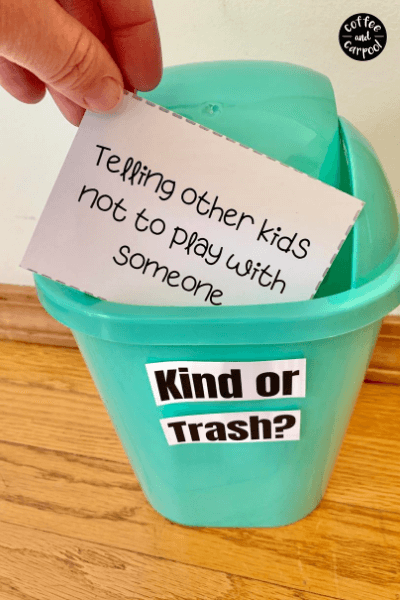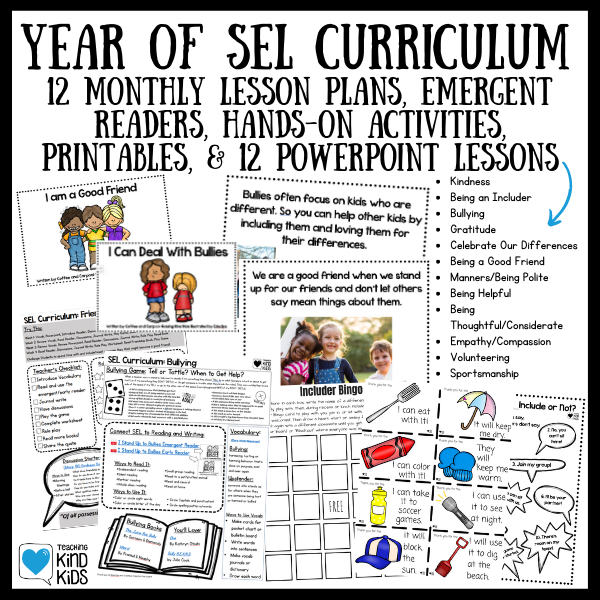Inside: Teach your students sel curriculum so you focus on raising kind kids who feel safe and secure enough to learn in your classroom.
My first year teaching, I was so excited to set up my classroom.
I created bulletin boards out of things my kid brother made me because I was short on money, but I was so proud of my classroom environment I created.
And then my principal handed me a stack of character education posters I had to post in my classroom.
I remember being really irritated because I didn’t want them up in my room. So I did was I was supposed to…I hung them up. But I hung them in the corner of my classroom, almost to the ceiling, where no kindergartner would ever see them.
As I started teaching, though, those posters about Honesty and Citizenship and Trustworthiness and Kindness stared down at me.
And the longer I taught, the more I realized that of course, I was there to teach reading and writing and math.
But I was also there to teach my students how to take turns, how to be compassionate, how to be helpers, and how to be kids who see someone drop everything and rush to help rather than laugh.
I started teaching anti-bullying and the Golden Rule and why it’s important to treat others with kindness.
I taught them how to befriend our more vulnerable students and stand up for them on the playground.
We spent just as much time talking about becoming kind people as we did talking about becoming smart people.
And even though the name changed from Character Education to Social-Emotional Learning, the importance hasn’t diminished.
We have to intentionally teach our students to be kind as part of our everyday curriculum, right alongside reading, writing, and math.

Why is it Crucial to Teach Social Emotional Learning?
Kindness begins at home. But so many of our students come to us from homes that don’t place value on kindness. Or they live in homes where their basic needs aren’t being met so kindness can’t be the focus.
So even though teachers already have enough on their plates and are stretched too thin, it comes down to educators to teach sel curriculum.
Social-Emotional Learning, or SEL, covers skills like understanding and managing emotions, building relationships and maintaining friendships with others in positive ways, treating others with empathy and acting on that with compassion, and making responsible choices.
How to be a good friend.
How to cheer on others and give them compliments.
How to take turns.
How to play fairly.
How to be honest and trustworthy.
In essence, how to be a good person.
But why is it essential that we teach this at school?
With all the standards teachers have to cover, is this really essential?
Do we really need to make time for it in our classrooms?
Social-Emotional Curriculum is essential in our classrooms because children who feel ostracized, excluded, lonely, or bullied won’t be able to focus on schoolwork. And if we unintentionally create a classroom community that allows exclusion and teasing and bullying, our students won’t feel safe to raise their hands or safe to play or safe to be themselves.
In order to get our students to be able to learn what we need to teach them, we have to create a positive and safe learning environment so they can find success.
The good news is we can intentionally teach our students to speak and act with kindness more often and create a community of kind children, ready and able to learn.
If our kids leave our classrooms and can read and write but laugh when others fall or tease classmates for making mistakes, then we will have not done our jobs fully.

How to Teach SEL Curriculum:
We all know we can’t teach our students the letter A one time and have them know it.
Just like we can’t teach them how to add once and they understand how to manipulate fact families.
We have to continually, repetitively, relentlessly teach them these concepts. Over and over again.
Some of our students will get it after we show them twice. But most will need to hear it many times from us.
So the same is true of teaching them how to be kind, compassionate people.
We can’t just hang up posters in the hallway or have a kindness assembly or tell them once to be kind.
Even if the posters are awesome like these Classroom Kindness Posters.
We have to talk about kindness all the time.
We have to remind them to be kind as they head out to the playground every day.
We have to praise kind behavior when we see it, even if it’s as simple as sharing a crayon.
Here’s how we can intentionally teach SEL curriculum to our students:
1. Talk about Kindness and Compassion
We need to talk about kindness so our students hear the message often.
We can use these 60 Kindness Discussion Starters or this Skittles Game or these Bullying Discussion Starters.
You could also grab these Compassion Cards to teach kids how to walk in someone else’s shoes.
They’re great to use during your morning meeting or if you have a few minutes before recess or lunch as a reminder before they have less adult supervision.
2. Play a Kindness Game
One of our favorite ways to reinforce concepts of kindness is to play the Trash or Kindness Game.
It allows kids to decide if social situations they encounter every day are kind or unkind. The unkind acts get ceremoniously thrown in the trash to serve as a reminder and give them the courage to make better choices when faced with peer pressure.
Related: Kindness Games to Teach SEL in a Fun Way
3. Read books about Kindness
We can read books about kindness, books about including others and books about bullying prevention.
We can also use these kindness bookmarks to start discussions about the characters in the stories we read.
4. Teach Kids to Celebrate our Differences
When we do more than just tolerate our differences and we teach kids to celebrate our differences, we help our kids understand that different doesn’t mean weird or scary. Since bullies tend to target kids who are different because they don’t understand our differences, we can bully-proof the kids in kids in our class and teach anti-bullying.
We can also intentionally look for bullying behaviors in our classroom with these strategies.
5. Read Emergent Readers or Early Readers About Kindness and write about it
Use these emergent reader sets or early reader sets to read non-fiction books with your kids.
When students are able to read the books independently, they take ownership of the books they read and the messages in them.
These emergent reader sets and early reader sets are perfect for our young students.
6. Encourage Acts of Kindness Every Day
Kindness is a verb. It’s something we do.
To encourage our kids to speak and act with kindness we can’t only talk about kindness. We need to challenge our students to speak and act with kindness. One of the most fun ways to do it is with our 100 Acts of Kindness.
With a kid-friendly kindness act every day, your students will not only be 100 days smarter in February, they’ll also be 100 days kinder. Kindness will become a habit for them if they do it every day for 100 days in a row.
7. Praise Kindness When you See It
To encourage kind behaviors we have to use positive reinforcement to encourage these behaviors to continue. We can offer verbal praise and praise the behavior or praise the child.
If we want to praise the behavior, we can say, “That was a kind thing you did” or if we want to praise the child, we can say, “You are kind for doing that.”
We can reward kids with these Caught Being Kind cards or we can use this Kindness Hole Chart to encourage kids who are struggling to speak and act with kindness and need extra encouragement.
8. Assign Work in your Lesson Plans to Teach Kindness
Our kids can start to show what they know with these kindness activities and creative writing assignments.
They can work independently on these activities and creative writing prompts and then we can follow up with the included kindness discussion topics.
9. Surprise kids with Kindness Gifts
Make and then hide these fun kindness pencils or encourage your students to make them for each other. They’re just a simple reminder that kindness is important.
10. Teach Kids to be Includers
We have to intentionally teach our kids to include other children. It’s as simple as teaching them to say, “Do you want to play with me?” or “You can sit here next to me,” or “Do you want to join our group?”
We can also teach them to use a Buddy Bench.
Kids who feel included and feel welcomed are less likely to be bullied and are more likely to come to school ready to learn.
And we will have successfully created a classroom community that treats each other with kindness, respect, and compassion.
Which is just as important as creating a classroom of kids who can read, write, and add.
11. BONUS: Use a Year Long Done for You SEL Curriculum
Instead of piecing together sel curriculum, use done for you, ready to go curriculum developed by an educator.
You’ll get 12 months of fun, hands-on activities that connect to other subject areas that focus on:
- Kindness (August)
- Being an Includer (September)
- Bullying (October)
- Gratitude (November)
- Celebrate Our Differences (December)
- Being a Good Friend/Friendship (January)
- Manners/Being Polite (February)
- Being Helpful (March)
- Being Thoughtful/Considerate (April)
- Empathy/Compassion (May)
- Volunteering (June)
- Sportsmanship (July)
Get the Year of SEL Curriculum here and take the guess work out.















Leave a Reply